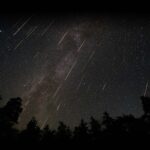The Annual Perseid Meteor Shower Peak Night is celebrated on August 9 every year. On this day, the peak of Perseid meteor showers takes place where they shine the brightest. You don’t need any special equipment or an expensive telescope to view these Perseid meteors. They can be seen with the naked eye in any part of the sky. However, it also depends on the weather in your location. Cloudy nights tend to block the view where only parcels of subtle glimmer can occur. But if the sky is dark and clear, you can experience this once-a-year phenomenon right at your home. Climb to your rooftop and lay on your back — you do not want to miss this magnificent experience.
History of Annual Perseid Meteor Shower Peak Night
Historically, the first observation of Perseid showers was performed by the Catholics back in 285 A.D. Closely followed by the martyrdom of Saint Lawrence, the Perseid shower phenomenon was widely believed to be the saint’s tears that return to the Earth once a year. It has been said that the saint was burned alive and that these meteor showers are sparks from the flame. Its cooled embers appear on the ground and are called ‘Saint Lawrence’s coal.’ This event immediately became the foundation of Saint Lawrence Day on August 10.From a scientific perspective, it was Belgian astronomer Adolphe Quetelet who recorded a greater frequency of Perseid meteors in 1836. After a year of study, he informed other astronomers that August 10 was his prediction of the meteor shower peak. True enough, it did happen on August 10, 1837. However, Quetelet missed the phenomenon due to bad weather conditions in his area. In 1866, Italian astronomer Giovanni Virginia Schiaparelli discovered the link between comets and Perseid meteor showers after the perihelion passage of Swift-Tuttle. This recorded theory was unearthed in an exchange of correspondence with fellow astronomer Angelo Secchi.This year, the Perseid meteor showers won’t be as grand as that in 2021 due to a bright full moon that will illuminate the sky. However, you can still see fragments of bright and sharp traces of meteors in the sky. According to NASA, you’ll be able to witness 100 meteors per hour if your view isn’t blocked by clouds. The best time to witness the peak is during pre-dawn hours when the sky is the darkest.
Annual Perseid Meteor Shower Peak Night timeline
Catholics claim that Perseids are teardrops from Saint Lawrence, who was burned alive before the first observation of meteor showers.
Belgian astronomer Adolphe Quetelet predicts that Perseids happen once a year on August 10.
Italian astronomers observed the Perseid showers as predicted by Adolphe Quetelet.
Italian astronomer Giovanni Virginio Schiaparelli links the presence of Perseids to the Swift-Tuttle comet.
Annual Perseid Meteor Shower Peak Night FAQs
When was the Comet Swift-Tuttle last seen?
Comet Swift-Tuttle last passed Earth in 1992.
Where is the best place to watch the Perseid Meteor Shower Peak?
The Perseids shine the brightest in Canyonlands National Park, Utah.
Why do meteors glow?
Meteors glow due to friction occurring as they enter the Earth’s atmosphere.
Annual Perseid Meteor Shower Peak Night Activities
-
Lay on your back and experience it yourself
There’s no better way to spend this night than by staying up late, climbing on your rooftop, and laying on your back. If the weather’s perfect, bright showers will illuminate the sky.
-
Watch “Curious George”
A T.V. series called “Curious George” showcases the Perseid meteor shower phenomenon in great detail. Check this show out and learn more about this astronomical event.
-
Check out “Puffin Rock” on Netflix
A more popular series available on Netflix also explores the grand phenomenon of Perseids. Check out “Puffin Rock.” It’s the best show to watch to set the mood before you witness the meteor shower.
5 Facts About Meteors And The Perseids
-
Peak meteor velocity
Perseids travel as fast as 37 miles per hour.
-
Largest object known to repeatedly pass Earth
Comet Swift-Tuttle, the largest object to pass Earth repeatedly, creates the debris known as the Perseids.
-
Earth’s atmosphere vaporizes the Perseids
Due to the heat of the atmosphere, the Perseids turn into a fireball that vaporizes as it enters Earth.
-
Swift-Tuttle to return in 2126
The next visit of Swift-Tuttle will be in 2126.
-
The origin of the term “meteor”
The term ‘meteor’ is derived from a Greek word which means ‘suspended in air.’
Why We Love Annual Perseid Meteor Shower Peak Night
-
It’s a fascinating phenomenon
If you’re an astronomy enthusiast with a great fascination with stars, meteors, and comets, this day is for you. Nothing beats the experience of seeing bright meteor showers in an hour-long timeframe with your naked eye.
-
It has a rich history and cultural relevance
Whether you see it from a religious or a scientific standpoint, you can’t deny that the Perseid meteor peak is a grand event. What’s more, it’s full of mysteries that mankind clings to.
-
It’s a cozy way to bond with your family
The Annual Perseid Meteor Shower Peak Night can be a family event that you and your kids can share. Grab a cozy blanket, hot chocolate, and comfy pillows, sit on your rooftop, and enjoy the view.
Annual Perseid Meteor Shower Peak Night dates
| Year | Date | Day |
|---|---|---|
| 2023 | August 9 | Wednesday |
| 2024 | August 9 | Friday |
| 2025 | August 9 | Saturday |
| 2026 | August 9 | Sunday |
| 2027 | August 9 | Monday |





















